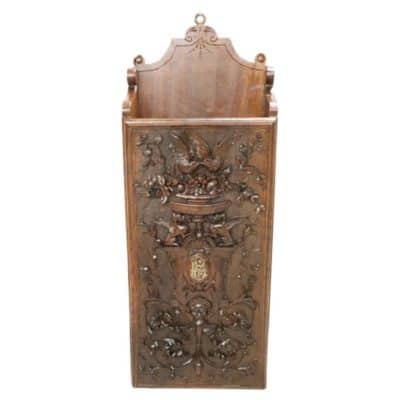#Early #French #Furniture #Styles #History #Culture
Embarking on a journey through French furniture styles takes us on a captivating exploration of history, culture, and artistic expression. In this first part of our dual-series, we focus on styles from the Middle Ages to the end of the 18th century.
French furniture design evolved in response to the societal, political, and cultural shifts that shaped the nation. Join us as we delve into this fascinating world. We will trace its origins, and investigate the profound influence of French history on its iconic styles.
The Middle Ages: The Roots of French Furniture Design
French furniture design traces its roots back to the Middle Ages when craftsmanship flourished amidst the feudal society. Influenced by Gothic architectural elements, furniture during this period reflected a sense of grandeur and verticality.
Ornate carvings, pointed arches, and elaborate tracery adorned pieces, showcasing the craftsmanship of skilled artisans. The design of dining chairs, for example, featured intricately carved details and sturdy construction. The furniture preference of this time mirrored the strength and durability required in medieval life.
Renaissance: Embracing Humanism and Classicism
The Renaissance period in France spanned from the end of the 15th century to the beginning of the 17th century, with the arrival of Louis XIII furniture. During this time, we witnessed a transformative shift in French furniture design, inspired by the rediscovery of classical Greek and Roman art and culture.
Take, perhaps, this Renaissance Style Magazine Rack. As humanism and classicism took center stage, furniture reflected a newfound appreciation for symmetry, proportion, and harmony. Influenced by Italian Renaissance styles, French furniture began to incorporate elegant curves, decorative motifs, and rich materials such as walnut and oak. This piece showcases incredible craftsmanship through hand carved details including a winged dragon and an expressive face.
Baroque: The Extravagant Splendor of Louis XIV
Enter the Baroque era, characterized by the reign of King Louis XIV and the rise of opulence and grandeur in French furniture design. Furniture from this period mirrored the king’s extravagant lifestyle and the desire to display wealth and power.
This French Bureau Brisé captures the values of this moment. Clearly, Louis XIV furniture style embraced lavishness, gilded details, and intricate ornamentation. Gilt bronze accents, richly carved woods, and sumptuous fabrics adorned pieces, creating an atmosphere of grandeur. A thin sheet of red-tinted tortoiseshell was laid atop a thin sheet of brass, and an intricate pattern was cut through both layers. This entire piece is an immaculate display of these design preferences. Homes became a focal point of entertainment and showcased the magnificence of the Louis XIV style era with intricately designed dining tables and chairs fit for royalty.
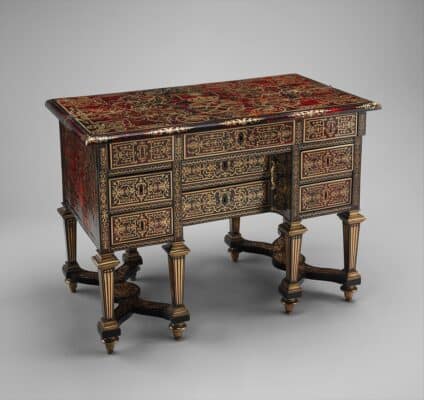
Rococo: The Curvaceous Delicacy of Louis XV Style
In the 18th century, the Rococo period emerged, marked by the reign of King Louis XV. This period ushered in a departure from the heavy grandeur of the Baroque era and embraced a more playful and delicate aesthetic. These pieces tend to have traditionally feminine, romantic ornate details.
In direct conversation with the Baroque piece discussed above, let’s examine this gorgeous French Louis XV Secretary Desk. This French Louis XV secretary desk dates back to around 1760 and comes from France. This exquisite piece stands out for its beautiful kingwood veneer and marquetry on an oak carcass. The secretaire with a serpentine shaped front stands on four curved legs which are embellished with foliate Rococo bronze applications.
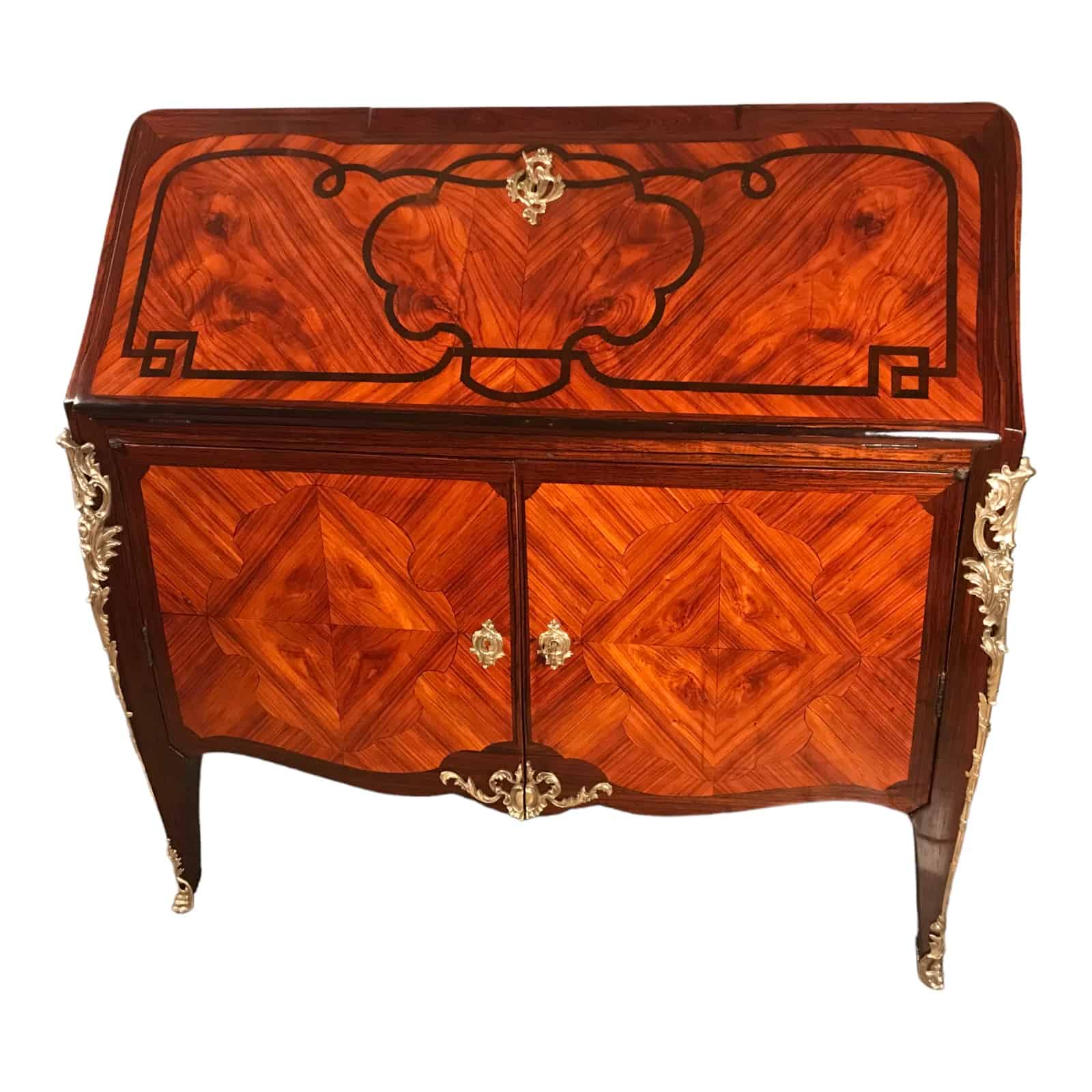
Louis XV style during this time celebrated curvaceous forms, intricate carvings, and whimsical motifs. Pieces were adorned with ornate floral patterns, sinuous lines, and light, airy compositions. Expensive woods, marquetry, and gilt bronze accents added a touch of luxury and refinement to these graceful pieces.
Transitional Style: 1755 to 1760 Ushers in a New Wave
Following the Rococo period of Louis XV furniture, we meet a new aesthetic. In the five years that followed, the forms of furniture and interior decoration began to change into what became known as the Second Style Louis XV, or the Style Transition. The rocaille decoration remained, but became more discreet and restrained.
Transformation commodes, the Secrétaire à la Bourgogne or the table a la Bourgogne were for example very popular. There are delightful displays of these in museums all over the globe, including at the Metropolitan Museum of Art.
But these are not only for viewing at museums. You can own a delightful commode and bring this rich history into your home. Available right now, this Transition Style French Commode features a glorious red leather writing surface and six drawers tucked beneath the top surface. Exquisite rosewood, satinwood and king wood flower shine in the marquetry on front, sides and top.
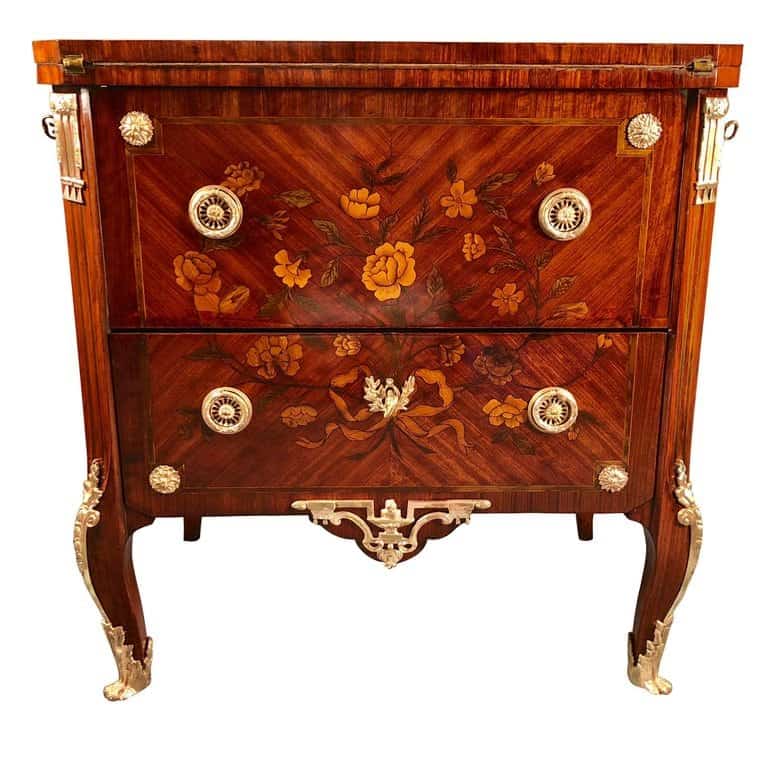
Neoclassicism: The Age of Enlightenment and Louis XVI
As the Age of Enlightenment dawned, a shift towards neoclassical aesthetics emerged in French furniture design. Inspired by the ideals of reason, order, and simplicity, Louis XVI furniture reflected a return to classical Greek and Roman influences.
This exquisite French Antique Secretary Desk speaks volumes of this era. The true triumph of Neoclassical aesthetics are evident here. Straight lines, geometric shapes, and restrained ornamentation characterized furniture of this period.
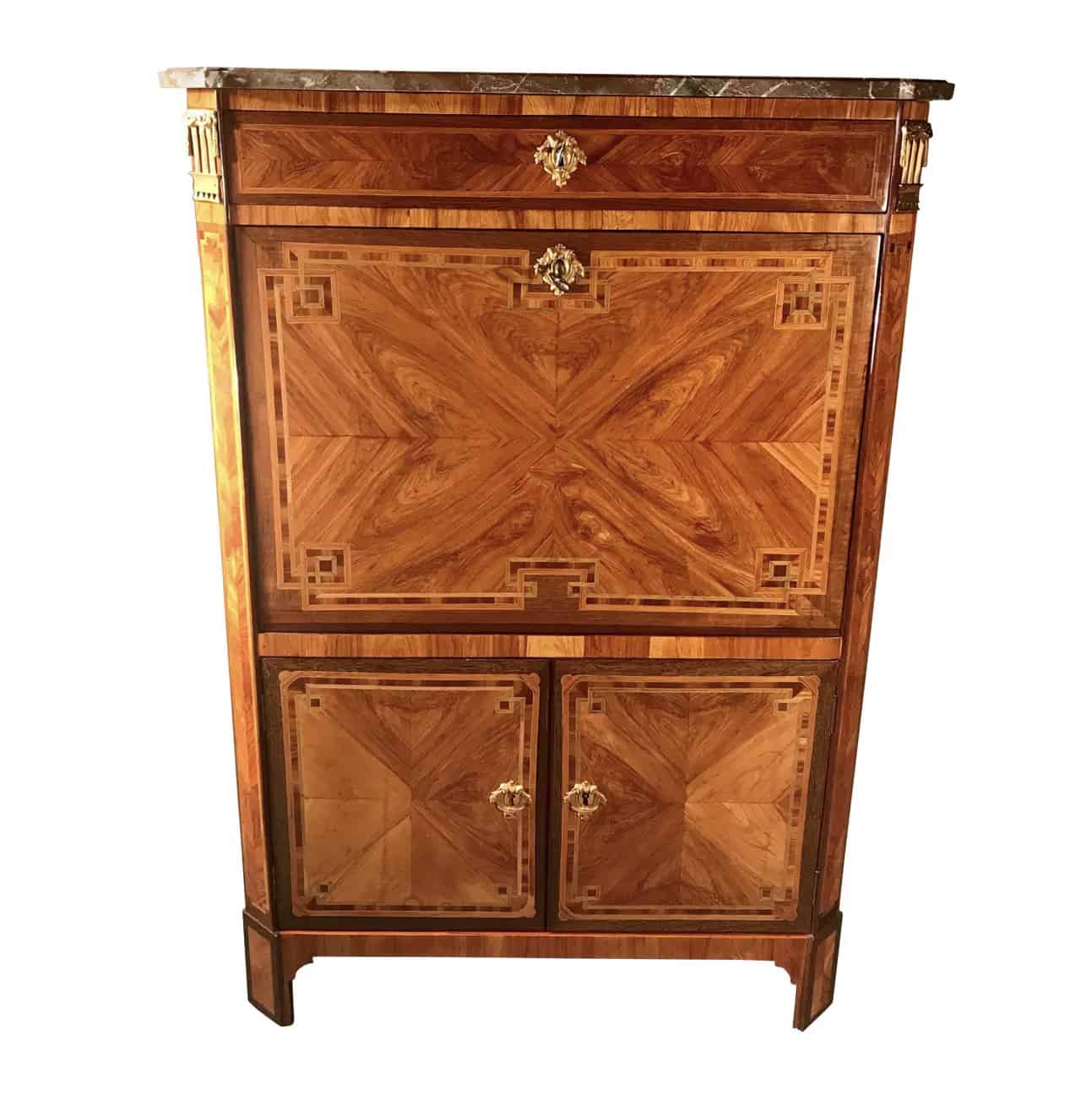
Mahogany and walnut were favored woods, while motifs inspired by ancient architecture adorned dining chairs, dressing tables, mirrors and cabinets. This period of Louis XVI style celebrated a balance between form and function, embodying the ideals of the Enlightenment.
Directoire Style: A Brief Impact
The Directoire period of furniture design in France spanned from 1795 to 1799. It was a transitional phase between the neoclassical aesthetics of Louis XVI and the empire style of Napoleon Bonaparte. Named after the Directory government that ruled France during this time, the Directoire style embraced simplicity, clean lines, and a departure from the ornate designs of the previous era.
This French Antique Chest of Drawers encapsulates this era in many ways. Like many furniture pieces from this period, the drawers have a more restrained ornamentation than the periods before. Previously predominant themes revolving around royal extravagance, noble power, and privilege were now perceived negatively. While this period was economically and socially troubled, personal wealth among private citizens grew. And as it did, so did the demand for furniture. Directoire furniture preserves the elegant and stately characteristics of earlier periods. But, like Gustavian design, the Directoire style is much more restrained. This moderation is evident in the elongated, uncomplicated shapes and clear lines of most pieces.
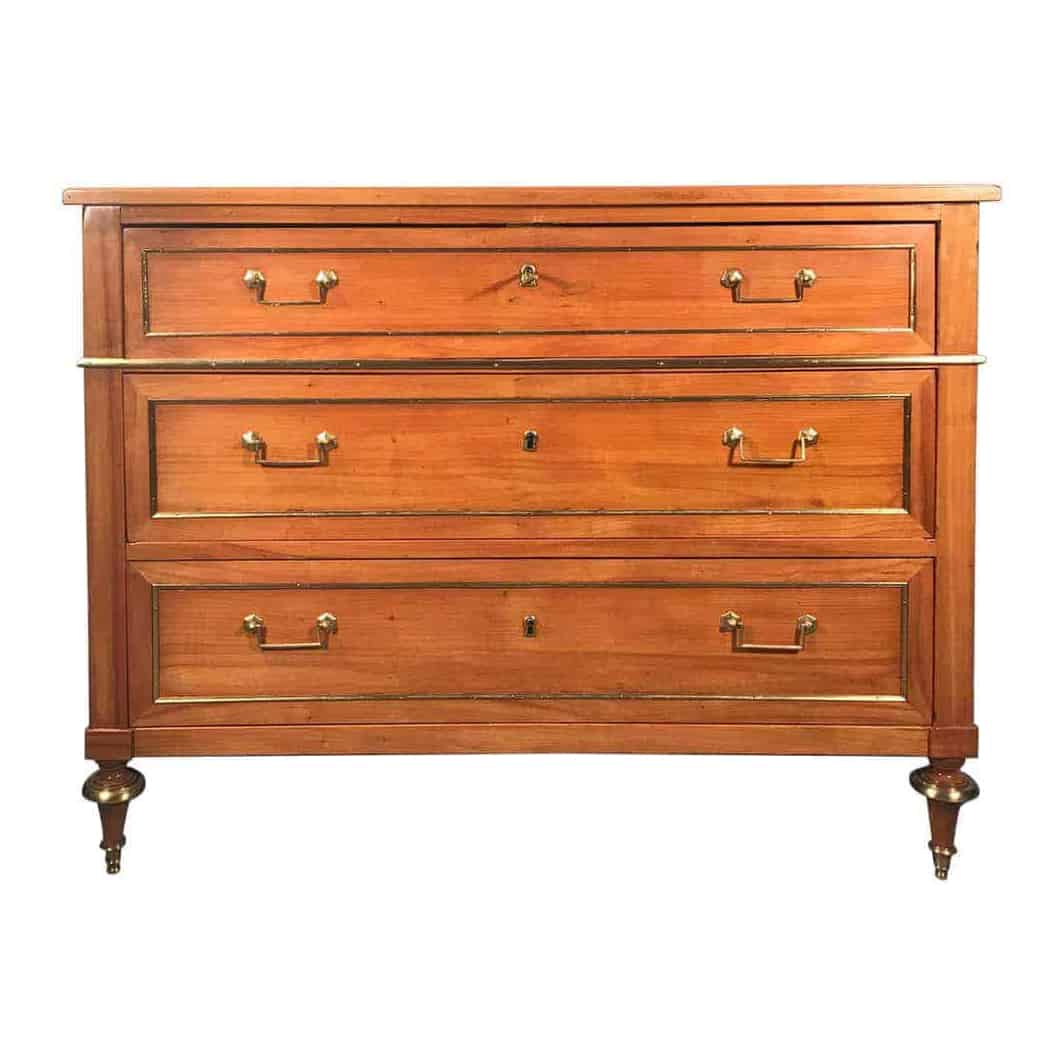
The Directoire period represents a brief but significant chapter in French furniture design, showcasing the evolving tastes and influences of the time.
French Furniture is Hand Carved by History
Furniture design is a testament to the intertwining relationship between history, culture, and artistic expression. We just scratched the surface of the expansive medieval influences of the Middle Ages to the opulence of the Baroque period, the delicate curves of the Rococo era, and the neoclassical elegance of the Enlightenment. French furniture styles tell a story of the nation’s evolution. Each style carries the essence of its respective historical era, capturing the spirit of French history and cultural heritage.
Join us for our next post where we will expand into the 19th century and beyond, discussing the restoration period, Louis Philippe style, Empire furniture, art nouveau style, art deco, and more brilliance of French furniture makers.
Let the enduring allure of French style grace your living spaces, bridging the gap between past and present. Styylish.com can provide you with endless antique, vintage and modern options for your home, and infusing your life with a touch of timeless beauty and sophistication.

